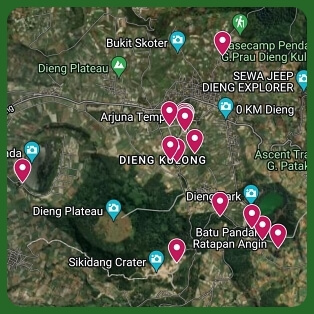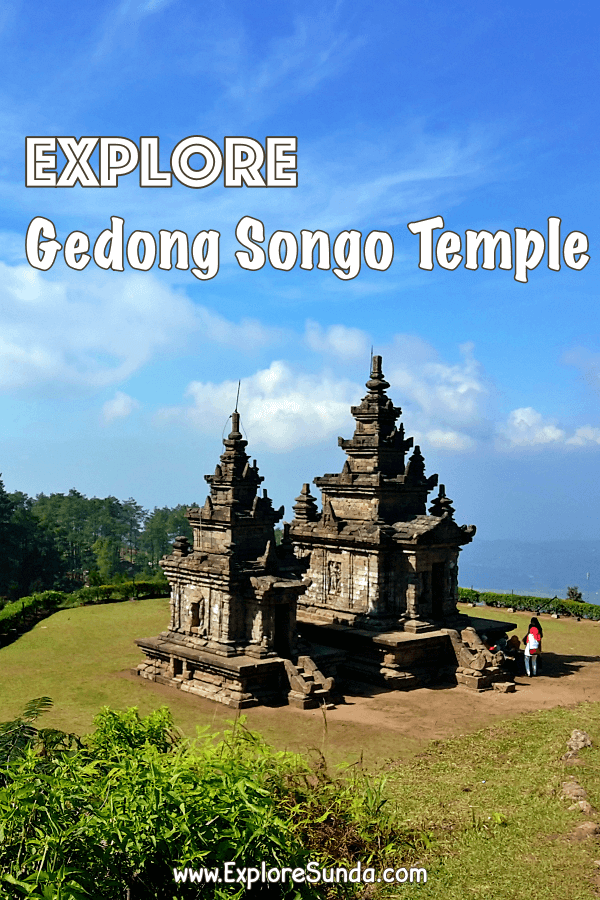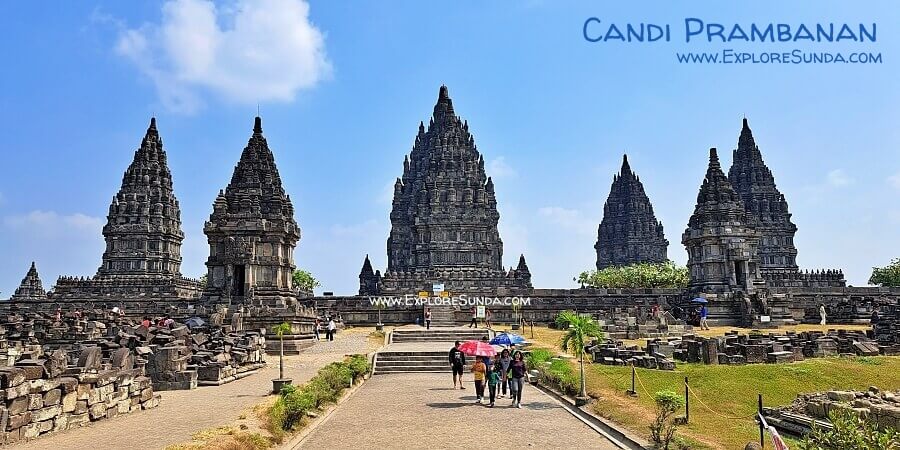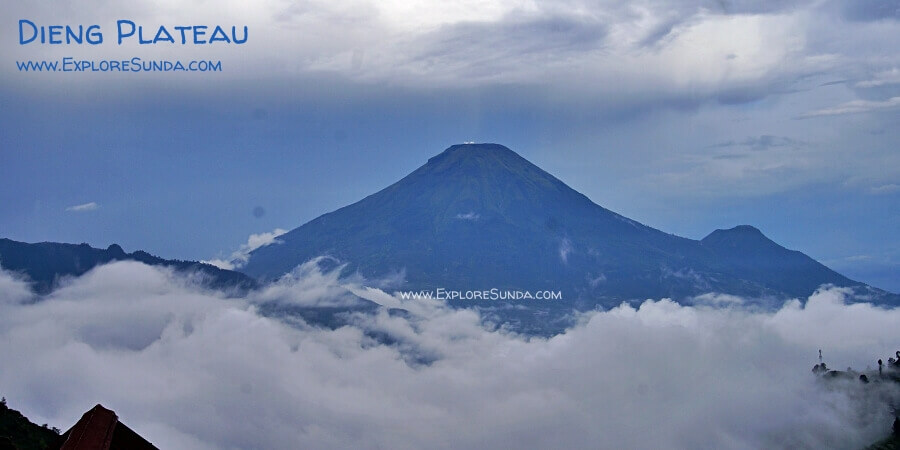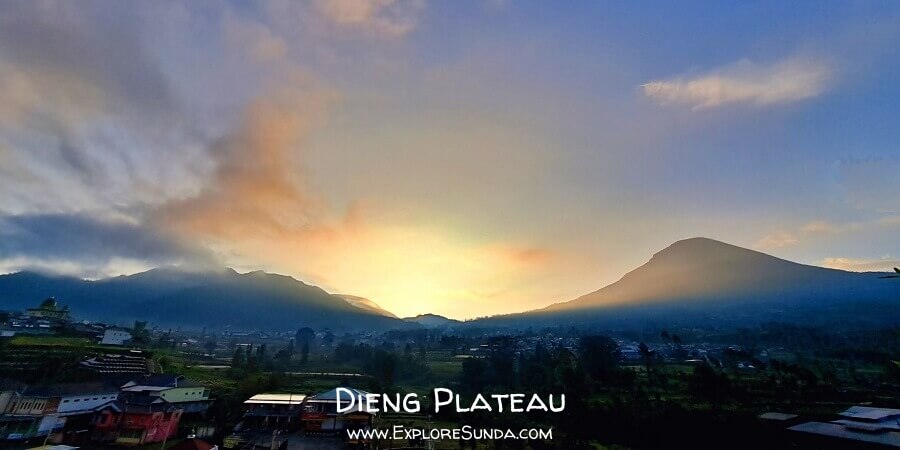- Sunda
- Dieng Plateau
- Candi Arjuna Complex
Candi Arjuna Complex & Ancient Temples in Dieng Plateau
Candi Arjuna complex in Dieng Plateau is one of the oldest Hindu temples built in Indonesia. According to the inscription found nearby, the temple was completed in 808 AD, during the reign of the Sanjaya dynasty from the Ancient Mataram Kingdom.
Candi is an ancient structure that served as a place of worship and often as a burial site for the ashes of late Hindu or Buddhist kings and priests. Although most of the Candi we see now are made of andesite stones, archaeologists have also discovered several Candi built of red bricks.
The temples in the Dieng Plateau are not as grand as Prambanan Temple. They are a cluster of small temples, each with foundations less than eight by eight meters, and heights of less than fifteen meters. They are scattered across the highlands of Dieng. All temples in the Dieng Plateau are Hindu temples and most are dedicated to Shiva. The inscription found nearby didn't mention the names of these temples, it was the locals who discovered them that gave names, most likely based on the relief on the temple walls with the Mahabharata Epic as the common theme.
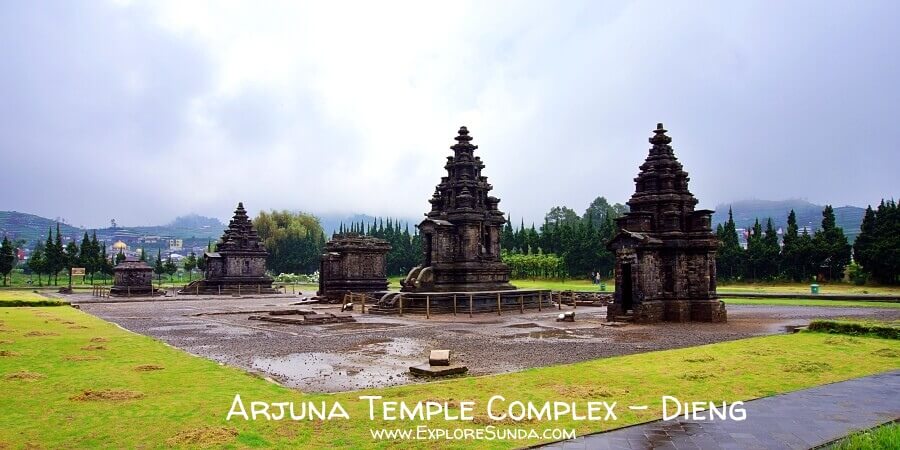 The five temples in Candi Arjuna Complex: Sembadra, Puntadewa, Srikandi, Arjuna, and Semar Temple (from right to left).
The five temples in Candi Arjuna Complex: Sembadra, Puntadewa, Srikandi, Arjuna, and Semar Temple (from right to left).Dieng is derived from the word Di, which means place, and Hyang, which means Gods. So, Dieng means God's abode. This is because people in early times believed that Gods lived in high places, especially in the highlands. Situated at over two thousand meters above sea level, the highland of Dieng is an ideal place for worship. Therefore, Dieng used to have hundreds of ancient Hindu temples built as early as the 7th AD. Sadly, only nine temples survive to this day. They are:
- Candi Arjuna Complex consists of the temples of Arjuna, Semar, Srikandi, Puntadewa, and Sembadra.
- Candi Setyaki,
- Candi Gatotkaca,
- Candi Bima,
- Candi Dwarawati.
Candi Arjuna Complex
Arjuna Temple Complex is the largest temple compound in the Dieng Plateau. It consists of five temples made of andesite stones. Intricate reliefs from the Mahabharata Epic adorned their walls. The roofs of the temples represent Mahameru (Mount Meru), the sacred five-peaked mountain from Hindu cosmology.
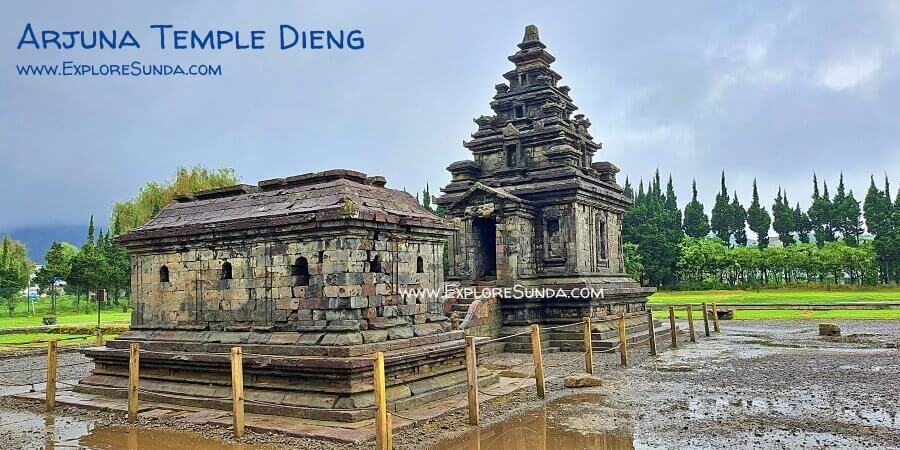 Candi Arjuna on the right and Candi Semar on the left, two temples at Arjuna Temple Compound in Dieng Plateau.
Candi Arjuna on the right and Candi Semar on the left, two temples at Arjuna Temple Compound in Dieng Plateau.Today, five temples are still standing here, they are:
- Candi Arjuna: the largest temple in the Dieng Plateau. It is dedicated to Shiva.
- Candi Semar was built at the same time as Candi Arjuna. It functioned as Candi Perwara, where worshipers brought their offerings and got ready before they conducted a ritual in Candi Arjuna. That’s why Candi Semar is facing Candi Arjuna.
- Candi Puntadewa, also known as Yudisthira – the eldest brother of Pandawa five from the Mahabharata epic, is situated in the center of this row of temples. Archaeologists approximated this temple was built around 812 to 838 AD, during the union of the Sanjaya and Syailendra dynasties as a dedication to Shiva. Reaching 12 meters in height, Candi Puntadewa is the tallest temple in the Dieng Plateau.
- Candi Srikandi is situated between Candi Arjuna and Candi Puntadewa. It is the only temple in this compound dedicated to Trimurti – the three highest Gods in Hinduism: Brahma, Shiva, and Vishnu. The outside walls of Candi Srikandi have reliefs of Vishnu on the north, Brahma on the south, and Shiva on the east wall. This temple was built around 928 AD.
- Candi Sembadra is the latest addition to the Arjuna Temple Compound. It is located at the end of the row and faces Candi Arjuna. Rakai Garung from the Sanjaya dynasty built it around 928 AD. It looked a bit different from other temples since it had an octagonal floor plan with a stone-carved lotus surrounded by seventeen small spires and a Ratna (Vajra) on its roof.
When Theodorf van Elf – a Dutch soldier – found this temple compound in 1814, these temples were partially submerged. A few years later (1856), HC Cornelius from England found a clogged drainage system inside the compound. Since then, the Arjuna temple compound has been relatively dry, even though their surrounding area is on higher ground.
Today, the Arjuna Temple Complex is the main tourist attraction in the Dieng Plateau, along with the golden sunrise, active craters, lakes, waterfalls, and tea plantations.
Candi Arjuna is the only temple in Dieng with an entrance ticket. The ticket is Rp. 30,000, including entry to Candi Setyaki, Candi Gatotkaca, and Sikidang Crater.
The Arjuna Temple Compound is situated amidst potato farms, approximately 200 meters from the ticket booth/parking lot if you start from this GPS coordinates 7°12'13.8"S 109°54'31.8"E. The other entrance to the temple complex is near the Gatotkaca temple, across the street from Dieng Kailasa Museum (The GPS coordinates are 7°12'13.8"S 109°54'31.8"E). Although you have to walk for 500 meters, I recommend this entrance, because it has a stone path leading to Candi Setyaki and Candi Arjuna. Colorful hydrangeas bloom beautifully on each side of the path. The only downside is that you must climb several steps to reach the parking lot.
It was raining when we arrived at Candi Arjuna. Without any shelter nearby, this temple compound was empty of visitors. The rain and mist added to the breathtaking view of this complex. If you are interested in learning the history of the Candi Arjuna complex, an elderly works as a freelance tour guide there, he has vast knowledge of the temple and can speak English.
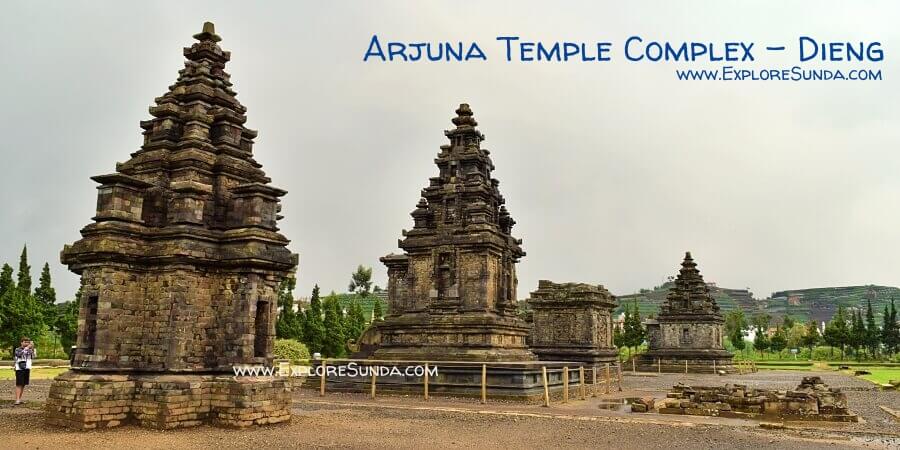 Temples in Candi Arjuna Compound are Hindu Temples dedicated to Shiva.
Temples in Candi Arjuna Compound are Hindu Temples dedicated to Shiva.Candi Setyaki is nearby, it is approximately 200 meters to the west of the Sambadra temple. You can even see the top of it from the Arjuna Temple Compound. You only need to follow the stone path near the Sambadra Temple.
Directions To Candi Arjuna Complex
Here is the map that shows the location of Candi Arjuna Complex and other places of interest in the Dieng Plateau. Since the Dieng Plateau is nestled among the mountains and somewhat remote, public transportation is rare almost nonexistent. On the other hand, as you can see from the map, the places of interest are spread out, so the most convenient way to travel between them is by driving your own car. Alternatively, you can join a tour from nearby cities like Yogyakarta and Semarang. If you're feeling adventurous, you might consider renting an open-top jeep, which can be found in the parking lot of Gatotkaca Temple.
Next:
Explore other temples in Dieng and the museum that keeps all the valuable items of the temples:
Recent Articles
-
Roro Jonggrang: A Tale Etched in the Stones of Prambanan Temple
Nov 05, 25 11:52 PM
Unravel the ancient Javanese legend of Roro Jonggrang that bridges myth, devotion, and the grandeur of Prambanan. -
Discover the Vibrant Celebration of Imlek in Indonesia!
Jan 13, 25 03:24 AM
The Chinese New Year of 2576 will be celebrated on January 29, 2025. Discover the special things in this Imlek festival! -
The Site Map of ExploreSunda.com
Nov 26, 24 10:40 PM
A thorough site map to help you browse through the Explore Sunda site.
